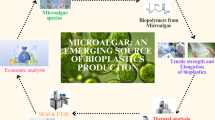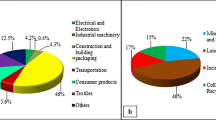Abstract
A new polymer composite was produced by using biochar derived from the Palm Oil Mill Effluent (POME) filler and high-density polyethylene (HDPE). Biochar particles produced through carbonization of organic waste of POME was melt mixed with HDPE at different biochar loading in the internal mixer. 10 wt% addition of biochar showed comparable processing characteristics, flow-ability and chemical resistance, and an enhanced thermal stability, tensile strength and tensile modulus compared to the neat HDPE. The thermal stability was enhanced by 9.2% based on the remaining residue upon combustion, whereas the tensile strength and tensile modulus was improved by 12.1 and 27.5%, respectively. POME-based biochar showed good capability as reinforcing filler for HDPE due to its good dispersion and presence of interaction through HDPE chain penetration at surface porosity of biochar as observed under scanning electron microscope images. The utilization of POME-based biochar as filler in HDPE composite, has great potential to mitigate organic waste from palm oil industries into value-added product. Moreover, the usage of fillers from waste material such as POME reduces the reliance on mineral based fillers from non-renewable resources such as calcium carbonate and silica.
Graphical Abstract











Similar content being viewed by others
References
Chavan S, Yadav B, Atmakuri A, Tyagi RD, Wong JW, Drogui P (2021) Bioconversion of organic wastes into value-added products: a review. Biores technol 344:126398. https://doi.org/10.1016/j.biortech.2021.126398
Visco A, Scolaro C, Facchin M, Brahimi S, Belhamdi H, Gatto V, Beghetto V (2022) Agri-food wastes for bioplastics: European Prospective on possible applications in their second life for a circular economy. Polym 14:2752. https://doi.org/10.3390/polym14132752
Ortega F, Versino F, López OV, Garcia MA (2022) Biobased composites from agro-industrial wastes and by-products. Emergent Mater. https://doi.org/10.1007/s42247-021-00319-x
Gunarathne DS, Udugama IA, Jayawardena S, Gernaey KV, Mansouri SS, Narayana M (2019) Resource recovery from bio-based production processes in developing Asia. Sustain Prod Consum 17:196–214. https://doi.org/10.1016/j.spc.2018.11.008
Darryl X (2022) Petrochemical feedstocks: three global trends to watch. Wood Mackenzie. https://www.woodmac.com/news/opinion/petrochemical-feedstocks-three-global-trends-to-watch/. Accessed 3 Dec 2022
Peng Y, Musah M, Via B, Wang X (2021) Calcium carbonate particles filled homopolymer polypropylene at different loading levels: mechanical properties characterization and materials failure analysis. J Compos Sci 5:302. https://doi.org/10.3390/jcs5110302
Shirvanimoghaddam K, Balaji KV, Yadav R, Zabihi O, Ahmadi M, Adetunji P, Naebe M (2021) Balancing the toughness and strength in polypropylene composites. Compos Part B: Eng 223:109121. https://doi.org/10.1016/j.compositesb.2021.109121
Siraj S, Al-Marzouqi AH, Iqbal MZ, Ahmed W (2022) Impact of micro silica filler particle size on mechanical properties of polymeric based composite material. Polym 14:4830. https://doi.org/10.3390/polym14224830
Zhao J, Wu D, Han JY, Jin Z (2014) Mechanical properties of fumed silica / HDPE composites. In Appl Mech Mater 633–634:427–430. https://doi.org/10.4028/www.scientific.net/amm.633-634.427
Ganapathi H, Phukan M (2020) Environmental hazards of limestone mining and adaptive practices for environment management plan. In: Singh R, Shukla P, Singh P (eds) Environmental processes and management. Water science and technology library 91. Springer, Cham
Homkhiew C, Boonchouytan W, Cheewawuttipong W, Ratanawilai T (2018) Potential utilization of rubberwood flour and sludge waste from natural rubber manufacturing process as reinforcement in plastic composites. J Mater Cycles Waste Manag 20:1792–1803. https://doi.org/10.1007/s10163-018-0749-y
Murugan S, Munusamy Y, Ismail H (2017) Effects of chicken eggshell filler size on the processing, mechanical and thermal properties of PVC matrix composite. Plast Rubb Compos 46:42–51. https://doi.org/10.1080/14658011.2016.1260217
Ramasamy S, Ismail H, Munusamy Y (2012) Preparation and characterization of rice husk powder incorporated natural rubber latex foam. Adv Mat Res 626:523–529. https://doi.org/10.4028/www.scientific.net/AMR.626.523
Ooi ZX, Chan KL, Ewe CY, Muniyadi M, Teoh YP, Ismail H (2017) Evaluation of water affinity and soil burial degradation of thermoplastic film derived from oil palm ash-filled polyvinyl alcohol. BioResources 12:4111–4122. https://doi.org/10.15376/BIORES.12.2.4111-4122
Muniyadi M, Ng TYS, Munusamy Y, Ooi ZX (2017) Mimusops elengi seed shell powder as a new bio-filler for polypropylene-based bio-composites. BioResources 13:272–289. https://doi.org/10.15376/BIORES.13.1.272-289
Kuram E (2020) Rheological, mechanical and morphological properties of hybrid hazelnut (Corylus avellana L.)/walnut (Juglans regia L.) shell flour-filled acrylonitrile butadiene styrene composite. J Mater Cycles Waste Manag 22:2107–2117. https://doi.org/10.1007/s10163-020-01094-3
Khanam PN, AlMaadeed MAA (2015) Processing and characterization of polyethylene-based composites. Adv Manuf Polym Compos Sci 1:63–79. https://doi.org/10.1179/2055035915Y.0000000002
Cui YH, Tao J, Noruziaan B, Cheung M, Lee S (2010) DSC analysis and mechanical properties of wood–plastic composites. J Reinf Plast Compos 29:278–289. https://doi.org/10.1177/0731684408097766
Mendes LC, Cestari SP (2011) Printability of HDPE/Natural fiber composites with high content of cellulosic industrial waste. Mater Sci Appl 2:1331–1339. https://doi.org/10.4236/msa.2011.29181
Sewda K, Maiti SN (2013) Dynamic mechanical properties of high density polyethylene and teak wood flour composites. Polym Bull 70:2657–2674. https://doi.org/10.1007/s00289-013-0941-0
Charoenvai S (2014) Durian peels fiber and recycled HDPE composites obtained by extrusion. Energy Proc 56:539–546. https://doi.org/10.1016/j.egypro.2014.07.190
Malaysian Palm Oil Board (2011). Environmental impact. http://www.palmoilworld.org/environment .html, 2011 Accessed 13 Aug 2020
Sumathi S, Chai S, Mohamed A (2008) Utilization of oil palm as a source of renewable energy in Malaysia. Renew Sustain Energy Rev 12:2404–2421. https://doi.org/10.1016/j.rser.2007.06.006
Nurul D, Aditya, K (2023) Commodities 2023: lower palm oil prices likely but markets wary of supply, recession risks. S&P Global Commodity Insights. https://www.spglobal.com/commodityinsights/en/market-insights/latest-news/agriculture/010323-lower-palm-oil-prices-likely-in-2023-but-markets-wary-of-supply-recession-risks. Accessed 3 Jan 2023
Bala JD, Lalung J, Ismail N (2014) Palm oil mill effluent (POME) treatment microbial communities in an anaerobic digester: a review. Int J Sci Research Publ 4:1–24. http://www.ijsrp.org/research-paper-0614.php?rp=P302812.
Peterson SC (2012) Evaluating corn starch and corn stover biochar as renewable filler in carboxylated styrene–butadiene runner composite. J Elast Plast 44:43–54. https://doi.org/10.1177/0095244311414011
Ronsse F, Hecke SV, Dickinson D, Prins W (2013) Production and characterization of slow pyrolysis biochar: influence of feedstock type and pyrolysis conditions. GCB Bioenergy 5:104–115. https://doi.org/10.1111/gcbb.12018
Gray M, Johnson MG, Dragila MI, Kleber M (2014) Water uptake in biochars: the roles of porosity and hydrophobicity. Biomass Bioenergy 61:196–205. https://doi.org/10.1016/J.BIOMBIOE.2013.12.010
Choi E, Kim S, Mam S, Gautam A, Bhandari R, Kim JY (2021) Maize straw and rice husk-derived biochars produced in a simple metal kiln: characteristics and effects on crop productivity in three fields. J Mater Cycles Waste Manag 23:2307–2317. https://doi.org/10.1007/s10163-021-01294-5
Nan N, DeVallance DB, Xie X, Wang J (2016) The effect of bio-carbon addition on the electrical, mechanical, and thermal properties of polyvinyl alcohol/biochar composites. J Compos Mater 50:1161–1168. https://doi.org/10.1177/0021998315589770
Das O, Sarmah AK, Bhattacharyya D (2015) A novel approach in organic waste utilization through biochar addition in wood/polypropylene composites. Waste Manage 38:132–140. https://doi.org/10.1016/j.wasman.2015.01.015
Das O, Sarmah AK, Bhattacharyya D (2015) A sustainable and resilient approach through biochar addition in wood polymer composites. Sci Tot Environ 512–513:326–336. https://doi.org/10.1016/j.scitotenv.2015.01.063
Ahmetli G, Kocaman S, Ozaytekin I, Bozkurt P (2013) Epoxy composites based on inexpensive char filler obtained from plastic waste and natural resources. Polym Compos 34:500–509. https://doi.org/10.1002/pc.22452
Zaverl MJ, Misra M, Mohanty AK (2013) Using factorial statistical method for optimising co-injected biochar composites. Proc 19th Int Conf Compos Mater 11:7802–7809.
Das O, Sarmah AK, Bhattacharyya D (2016) Biocomposites from waste derived biochars: mechanical, thermal, chemical, and morphological properties. Waste Manage 49:560–570. https://doi.org/10.1016/j.wasman.2015.12.007
Das O, Sarmah AK, Zujovic Z, Bhattacharyya D (2016) Characterisation of waste derived biochar added biocomposites: chemical and thermal modifications. Sci Tot Environ 550:133–142. https://doi.org/10.1016/j.scitotenv.2016.01.062
Zhang Q, Yi W, Li Z, Wang L, Cai H (2018) Mechanical properties of rice husk biochar reinforced high density polyethylene composites. Polym 10:286–295. https://doi.org/10.3390/polym10030286
Ketabchi MR, Khalid M, Walvekar R (2017) Effect of oil palm EFB-biochar on properties of PP/EVA composites. J Eng Sci Technol 12:797–808
Poulose AM, Elnour AY, Anis A, Shaikh H, Al-Zahrani SM, George J, Al-Wabel MI, Usman AR, Ok YS, Tsang DCW, Sarmah AK (2018) Date palm biochar-polymer composites: an investigation of electrical, mechanical, thermal and rheological characteristics. Sci Tot Env 619–620:311–318. https://doi.org/10.1016/j.scitotenv.2017.11.076
Giorcelli M, Savi P, Khan A, Tagliaferro A (2019) Analysis of biochar with different pyrolysis temperatures used as filler in epoxy resin composites. Bio Bioe 122:466–471. https://doi.org/10.1016/j.biombioe.2019.01.007
Giorcelli M, Khan A, Pugno NM, Rosso C, Tagliaferro A (2019) Biochar as a cheap and environmental friendly filler able to improve polymer mechanical properties. Biom Bioe 120:219–223. https://doi.org/10.1016/j.biombioe.2018.11.036
Morawiec J, Pawlak A, Slouf M, Galeski A, Piorkowska E, Krasnikowa N (2005) Preparation and properties of compatibilized ldpe/organo-modified montmorillonite nanocomposites. Eur Polym J 41:1115–1122. https://doi.org/10.1016/j.eurpolymj.2004.11.011
Ismail H, Mathialagan M (2011) Curing characteristics, morphological, tensile and thermal properties of bentonite-filled ethylene-propylene-diene monomer (EPDM) composites. Polym Plast Technol Eng 50:1421–1428. https://doi.org/10.1080/03602559.2011.584244
Ho MP, Lau KT, Wang H, Hui D (2015) Improvement on the properties of polylactic acid (PLA) using bamboo charcoal particles. Compos Part B Eng 81:14–25. https://doi.org/10.1016/j.compositesb.2015.05.048
Kundie F, Azhari CH, Muchtar A, Ahmad ZA (2018) Effects of filler size on the mechanical properties of polymer-filled dental composites: a review of recent developments. J Phy Sci 29:141–165. https://doi.org/10.21315/jps2018.29.1.10
Promraksa A, Rakmak N (2022) Biochar production from palm oil mill residues and application of the biochar to adsorb carbon dioxide. Heliyon 6:e04019. https://doi.org/10.1016/j.heliyon.2020.e04019
Stuart BH (2004) Infrared spectroscopy: fundamentals and applications. Wiley, England
Charles J, Ramkumaar GR (2009) Qualitative analysis of high density polyethylene using FTIR spectroscopy. Asian J Chem 21:4477–4484
Krehula LK, Katančić Z, Siročić AP, Hrnjak-Murgić Z (2014) Weathering of high-density polyethylene-wood plastic composites. J Wood Chem Technol 34:39–54. https://doi.org/10.1080/02773813.2013.827209
Demir H, Atikler U, Balköse D, Tıhmınlıoğlu F (2006) The effect of fiber surface treatments on the tensile and water sorption properties of polypropylene–luffa fiber composites. Compos Part A Appl Sci Manuf 37:447–456. https://doi.org/10.1016/j.compositesa.2005.05.036
Kanagaraj S, Guedes RM, Oliveira MSA, Simões JAO (2008) Dynamic mechanical analysis of multi-walled carbon nanotube/HDPE composites. J Nanosci Nanotechnol 8:4008–4012. https://doi.org/10.1166/jnn.2008.AN53
Norshahida S, Hanafi I, Zuraida A (2013) The effect of kenaf core fibre loading on properties of low density polyethylene/thermoplastic sago starch/kenaf core fiber composites. J Phys Sci 24:97–115
Behazin E, Ogunsona E, Rodriguez-Uribe A, Mohanty AK, Misra M, Anyia AO (2016) Mechanical, chemical, and physical properties of wood and perennial grass biochars for possible composite application. BioResources 11:1334–1348. https://doi.org/10.15376/biores.11.1.1334-1348
Balaji V, Tiwari AN, Goyal RK (2011) Fabrication and properties of high performance PEEK/Si3N4 nanocomposites. J Appl Polym Sci 119:311–318. https://doi.org/10.1002/app.32750
Al-Maharma A, Al-Huniti N (2019) Critical review of the parameters affecting the effectiveness of moisture absorption treatments used for natural composites. J Compos Sci 3:1–27. https://doi.org/10.3390/jcs3010027
Fang Q, Chen B, Lin Y, Guan Y (2014) Aromatic and hydrophobic surfaces of wood-derived biochar enhance perchlorate adsorption via hydrogen bonding to oxygen-containing organic groups. Environ Sci Technol 48:279–288. https://doi.org/10.1021/es403711y
Sweety S, Hasan M (2020) Jute/Coir/Banana fiber reinforced bio-composites: critical review of design, fabrication, properties and applications. Encyc Renew Sustain Mater 2:751–756
Nizamuddin S, Jadhav A, Qureshi SS et al (2019) Synthesis and characterization of polylactide/rice husk hydrochar composite. Sci Rep 9:5445–5456. https://doi.org/10.1038/s41598-019-41960-1
Hulugappa B, Achutha MV, Suresha B (2016) Effect of fillers on mechanical properties and fracture toughness of glass fabric reinforced epoxy composites. J Miner Mater Charact Eng 4:1–14. https://doi.org/10.4236/jmmce.2016.41001
Kusuktham B, Teeranachaideekul P (2014) Mechanical properties of high density polyethylene/modified calcium silicate composites. SILICON 6:179–189. https://doi.org/10.1007/s12633-014-9204-4
Gouda O, Mahmoud S, El-Gendy A, Haiba A (2014) Improving the dielectric properties of high density polyethylene by incorporating clay-nanofiller. World J Eng and Technol 2:289–297. https://doi.org/10.4236/wjet.2014.24030
Acknowledgements
The authors would like to thank Universiti Tunku Abdul Rahman to provide necessary materials and equipment to conduct this research.
Author information
Authors and Affiliations
Corresponding author
Additional information
Publisher's Note
Springer Nature remains neutral with regard to jurisdictional claims in published maps and institutional affiliations.
Rights and permissions
Springer Nature or its licensor (e.g. a society or other partner) holds exclusive rights to this article under a publishing agreement with the author(s) or other rightsholder(s); author self-archiving of the accepted manuscript version of this article is solely governed by the terms of such publishing agreement and applicable law.
About this article
Cite this article
Muniyadi, M., Munusamy, Y. & Xin, H.H. Palm oil mill effluent-derived biochar-filled high-density polyethylene composites: processability and physico-mechanical properties evaluation. J Mater Cycles Waste Manag 26, 252–265 (2024). https://doi.org/10.1007/s10163-023-01829-y
Received:
Accepted:
Published:
Issue Date:
DOI: https://doi.org/10.1007/s10163-023-01829-y




